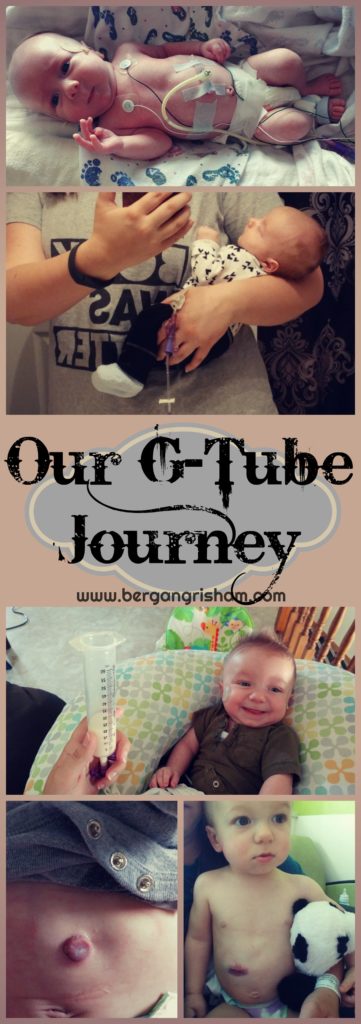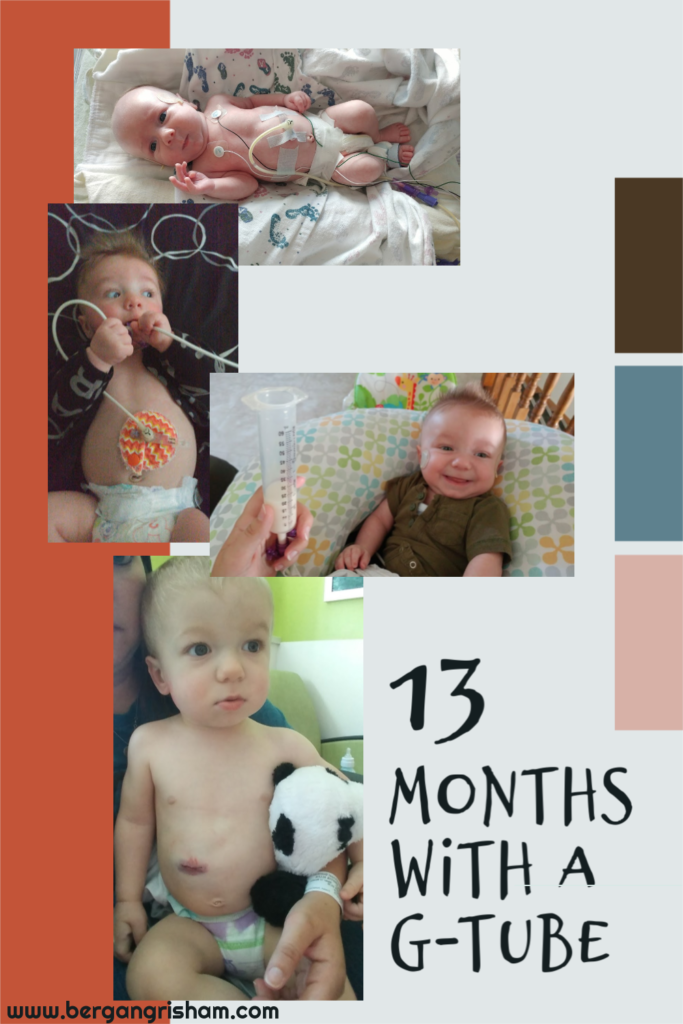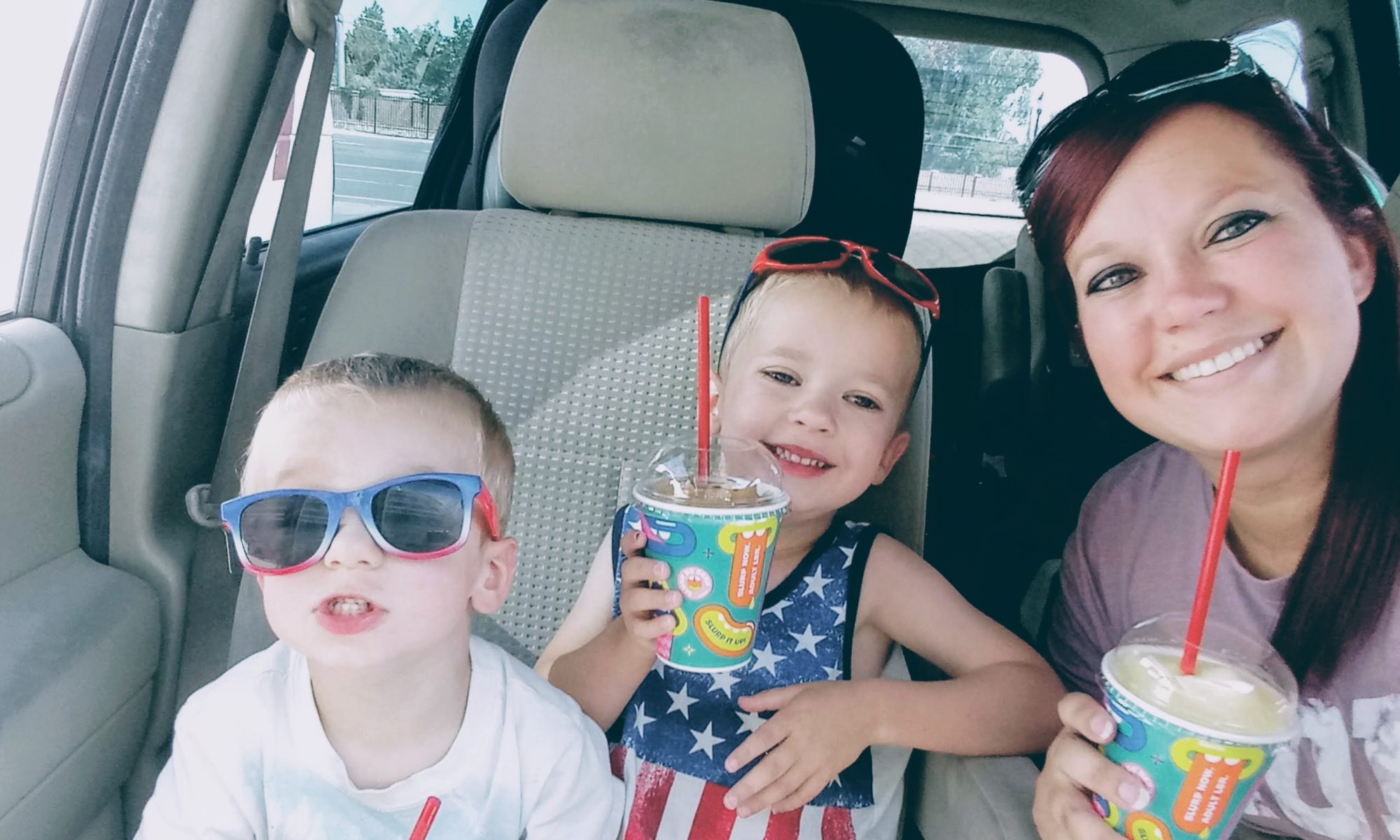I missed the phone call. The voicemail made my heart drop. The NICU nurse called to say my baby was stable, but I needed to call back. Thankfully we only got this call once during his 39-day NICU stay. Once was more than enough.
Continue reading “When Your Baby Aspirates”Our G-Tube Journey
This post contains affiliate links. I get commissions for purchases made through these links.
This last week was Feeding Tube Awareness Week. Even though a year ago I felt pretty confident in my feeding tube knowledge and experience, I felt a little strange about it this year. My little guy had a g-tube for all of 13 months. He was only fed fortified breast milk and formula through his tube. I know of so many families who use feeding tubes for years and years. But I decided that every feeding tube story is important, so here is ours:
My little man got his g-tube at five weeks old. He’d had problem after problem and after aspirating, being diagnosed with reflux and larygnomalacia, being NG-tube fed for weeks, taking medications, and trying thickened milk, he aspirated again. The doctors called us in to have a chat. Because my husband and I both wanted to be there and we had our two-year-old, we met in a conference room outside of the NICU.
Basically, they simply recommended a g-tube. I’d guessed as much and jumped right on board. I had no idea what I was getting into, but after nearly 5 weeks of trying to find solutions, I would have done anything to get my little boy home. It took a few days to get him transferred to the children’s hospital that could place the tube and several more days to get the ball rolling.
I got to the hospital early on surgery day. I snuggled my little guy and waited while the surgery time moved later and later. I finally took him down with the nurse and watched the doctor wheel him away. Conveniently enough, the g-tube class was taught right during his surgery. My parents and husband came and took the class with me so several of us would know how to take care of him. To be honest, I got pretty lightheaded as the teacher explained everything. I started to question whether I could handle the tube.

Griffin had never had to be intubated, so that was hard to see. I was scared to hold him with the tube. I didn’t want to hurt him or accidentally pull it out. Over the next several days I learned about caring for the tube site and feeding him through the tube. To be honest, I didn’t feel very prepared when we took him home five days post-op, but I learned quickly. I had to. We had home health visits for a few weeks and lots of check-ups. I asked every question, even the ones that seemed silly. I didn’t want to do anything wrong.
Medical supplies soon became our new normal. From the feeding pump and pole to the piles of tape and gauze and ointments to the pump parts and syringes and milk storage bottles I had to wash constantly. It started to seem weird that there were people who didn’t feed their baby with a tube…which is especially strange since my first son was simply breastfed. I guess you just get used to whatever your current normal is.
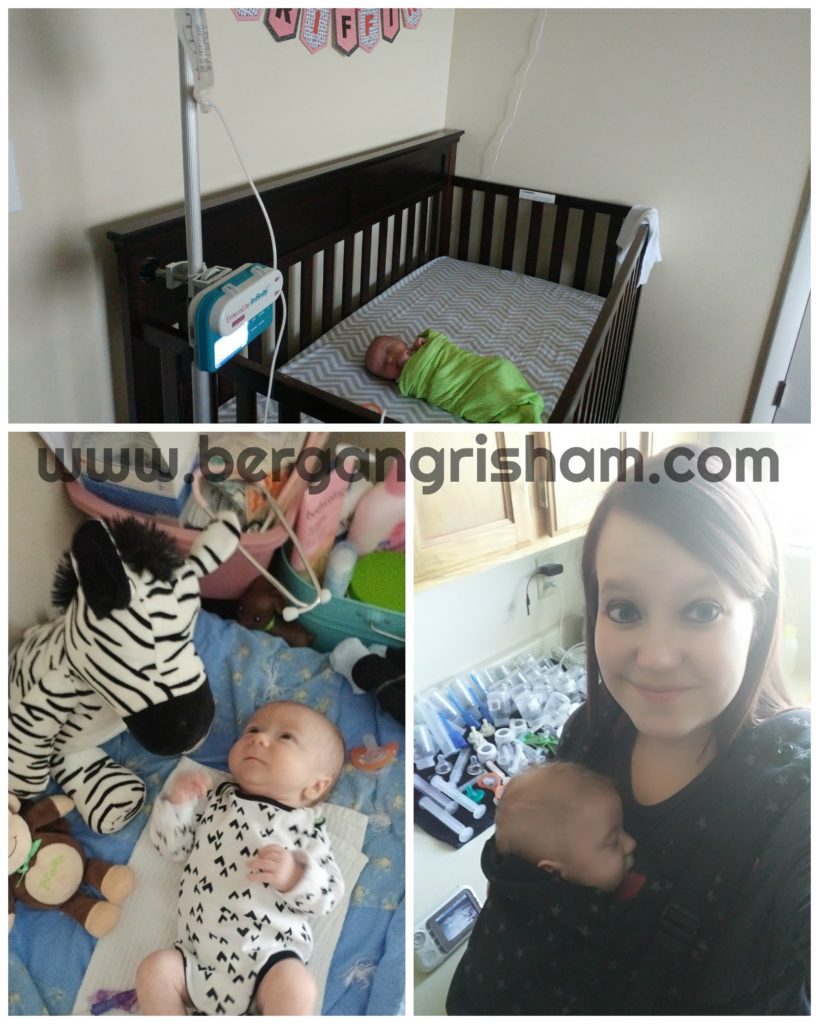
My older son was 2.5 and didn’t have really any experience with babies, and especially not with how they are fed. Griffin’s 39-day stay in the NICU was his normal. Griffin’s feeding tube was his normal. We taught him to be careful with the tube. The hospital gave him a little doll that had a g-tube and a bunch of supplies, so he got to practice taking care of his baby. It amazes me how kids can adapt. I had been so worried about splitting my time and taking care of two littles. Turns out, all the medical stuff took even more time than I expected taking care of another child would take. And yet my toddler handled it so well.
Because Griffin aspirated, he got all of his nutrition through his tube. This meant that I couldn’t breastfeed. In the beginning of our NICU stay, the plan had been to work on breastfeeding, but after he aspirated twice (the second time on thickened milk), all hope of breastfeeding went out the window. Because I had already been pumping for weeks and felt like it was one of the only things I could do for him, I kept going. It was time consuming, but I didn’t mind it too much.
It got harder when Griffin came home from the hospital. I pumped for over three months before my toddler started to be obviously upset by it. He didn’t like how much time I spent attached to the pump. Because of all he was going through with this and for my own sanity in the situation, I slowly stopped pumping for him. I had so much milk saved in the freezer that I was able to give Griffin fortified breast milk for the first six months, and I don’t regret stopping at all. It was what was best for us.

I slowly learned how to balance everything. I stopped using the pole for the feeding pump during the day and just left the feeding pump in the backpack. That gave us more freedom to move around the house and made us more prepared to leave the house. I just made sure to plug the pump in when Griffin was sleeping so it wouldn’t die. He was on a schedule of being fed over an hour starting every three hours and then nine hours at night. As a result, our longest time without the pump was two hours.
It is hard to leave the house and get back in two hours, especially with two little kids. So we learned to feed on the go. I started babywearing once his tube site was healed enough. My Tula Free-to-Grow carrier was the best for this. The strap was perfect for clipping the backpack onto with a carabiner.

Life felt pretty crazy for a while. But crazy in a good way. I allowed myself some grace because I knew there would be an adjustment to two kids, plus there were so many appointments and therapies and dozens of other things I hadn’t expected. I have several pictures like the following one from that time. When I’d look around the room or the house and realize just how much chaos there was. This picture was from when we still used the pole for the feeding pump. You can see Mr. Griffin on his play mat and my breast pump next to him. I had to multitask feeding him, entertaining him, pumping more milk, entertaining my toddler, and trying to maintain my sanity.
Originally this picture made me feel a little like I was failing. Now I feel like it’s kind of beautiful.
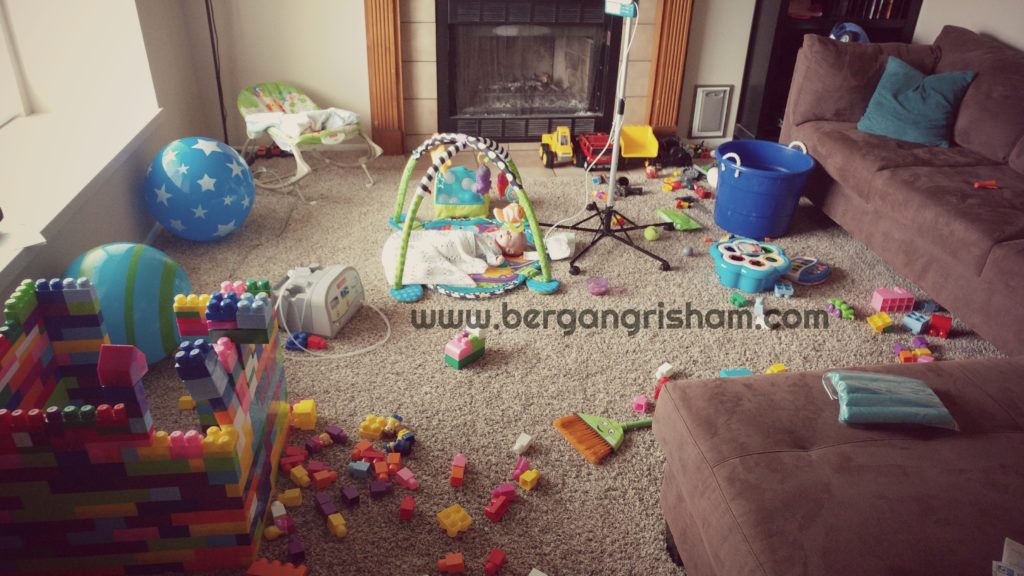
Griffin’s feeding tube didn’t rule our lives, but it was ever present during those first six months or so. I didn’t try to hide it in pictures because that was our life. I think it shows how tough he is. We didn’t have exact expectations for how he would progress. He had hypertonia (tight muscles) and his stridor (noisy breathing) got really bad. When he was four months old he had several episodes in one week when he would turn blue/grey and stop breathing. He had surgery within the week.
Griffin had a suppraglottoplasty to get rid of the extra skin in his airway to help him breathe better. This came weeks after finding out he needed oxygen while he slept. It felt like a step backward, needing oxygen, and it felt like a huge inconvenience. He only needed it when he slept, but have you ever met a four-month-old? They sleep randomly all throughout the day. After surgery, he was able to come off oxygen for good.
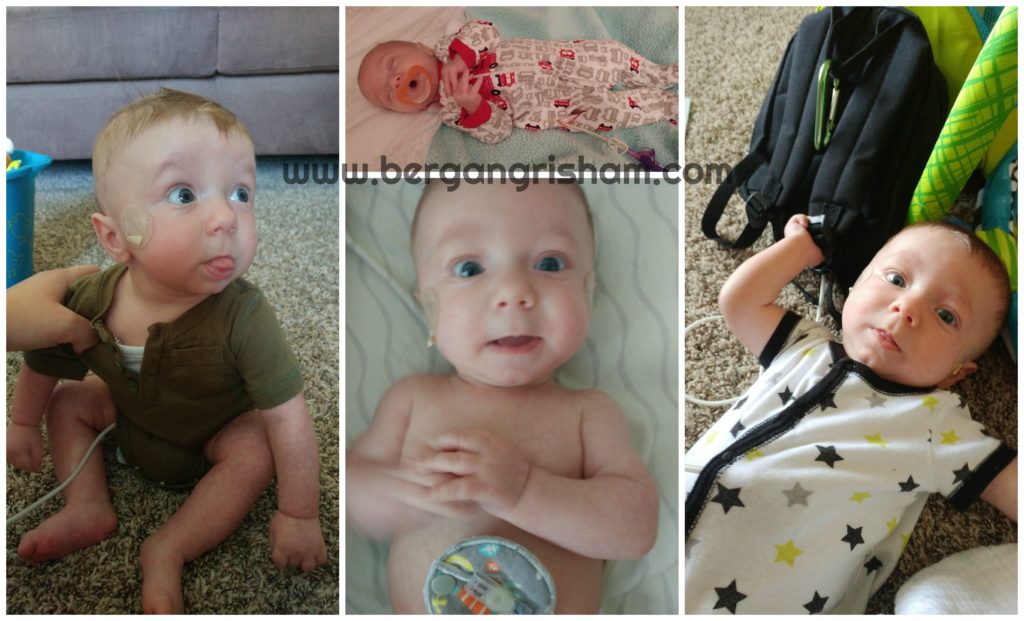
For the first several months after he got his g-tube, we didn’t worry about oral feeding at all. He took a binki, which was good practice for feeding, but that was about it. We slowly started feeding thickened milk 15 ml at a time (which is NOT very much). We had a feeding therapist who came to our house. I really loved all of the connections we had with doctors and therapists. I relied on them for all the information I didn’t know about how to care for my own child. I loved sharing Griffin’s accomplishments with them. They understood how hard all of the things he was doing could be.
It took a few months before Griffin took more than half of his feeds by mouth during the day. At that point we were able to gravity feed the rest (as shown below). It was a game-changer. No more pump during the day! He still took 9 hours of feeds at night, but that was easy, and honestly, he slept through the night after like the first week home thanks to a constantly full belly.

We got the go ahead to start purees around seven months. Griffin was excited, but it was stressful. Knowing he was tiny and needed fortified food and had to have things thickened and needed every bit of nutrition we could give him was stressful. There is something to be said for tube feeding and knowing just how much your child is getting. Between bottles and gravity feeds and spitting up and trying new purees, feeding just seemed to get more complicated.
Over time we got more used to it and slowly started to thin out his milk. The feeding therapist would watch and we’d monitor how long it took him to drink and how much he drank and if we needed a different size nipple on his bottle or whether the milk was too thick or too thin. I had lists of things to look for and when to be concerned. It was a balancing act.
When he was 11 months old we did a swallow study to see whether we could get him off of thickener. No such luck. He wasn’t aspirating, but he also wasn’t handling the liquid well. He had “deep penetration” and let the liquid go all the way down to his vocal cords before correcting it. (He used thickener for another eight months or so.)
He’d barely been using his tube by that point, but because it was cold and flu season, we left it in until April, when he was 14 months old. I was so excited for them to take it out, but I was also anxious. I had been comforted by the thought that if he did get sick or wasn’t taking in enough liquid or calories, I could give more to him. It felt strange that I wouldn’t have that option.
I think I expected more from that last appointment. After all of the stressing about not letting the g-tube button come out, it was strange to just watch the doctor take the button out, cover his stoma with gauze, and send us on our way. (For the record, his button did come out twice. I was alone both times. One time he pulled it out when I was changing him. I looked from my toddler back to Griffin, and he was holding the button and examining it. The other time I was playing with him. He was on his belly and I pulled his legs to bring him back to me. Even as I was doing it I knew it was a mistake. Somehow, after the initial panic, I just dealt with it. You adapt and do what you have to do.)

I actually have a whole blog post about how Griffin healed after having his g-tube removed. Spoiler: it was not simple and didn’t go as I had planned. He ended up having his stoma surgically closed.
I am so grateful that my little man has progressed so well and no longer needs a feeding tube. But I am also so incredibly grateful that he had one. Not only did it enable us to take him home from the hospital and safely feed him, but it taught me so much. Yeah, I learned a lot about the medical side of things. But I also learned not to judge so harshly. It opened me up to a new world of families that use g-tubes. It taught me how strong I could be and how I could handle whatever I needed to for my child.
Griffin may not have a feeding tube anymore, but I still feel strongly about the importance of feeding tubes and the awareness of them.
*****I have several other posts about feeding tubes here on my blog. Check them out!*****
